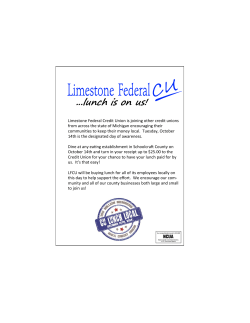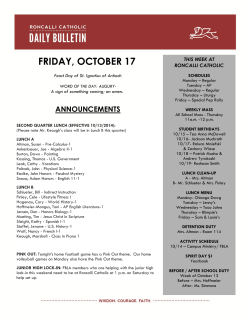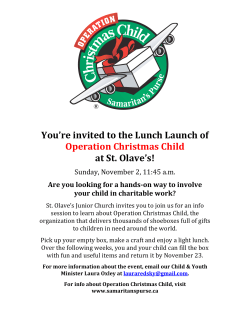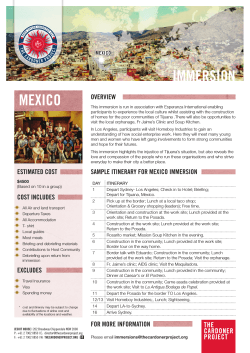
CONTINUOUS IMPROVEMENT Turning Sticky Notes Into Teamwork And Quality Assurance Ashley Weese
CONTINUOUS IMPROVEMENT Turning Sticky Notes Into Teamwork And Quality Assurance Ashley Weese Iowa State University OVERVIEW OF IT SERVICES IT Services Customer Services Systems and Operations Solution Center Employee Technical Services Student Technical Services Academic Technology Administrative Services Network and Communications WHO WE SUPPORT Employee Technical Services Account Management Research Groups Students/ Emeritus Core (limited) CorePlus (Annual Fee) Administrative Colleges Departments WHO WE WERE AT THE TIME • Employees did not have the same skill levels • Low moral • Employees who didn’t want to assist others • Overthinking • Lots of uncertainty due to budget • Employees were put off from the leadership change • Employees were relocated to be within earshot of each other • Single Point Of Contact (SPOC) GOALS • What do we do? • What expectations do we have for each other/ourselves? • Reduce the amount of time the customer waits for service • Create a team atmosphere • Improve quality • Gain trust throughout our team and the IT Services department • Improve moral • Start TCO – Total Contact Ownership IDEAS… WHERE IN THE WORLD DID WE COME UP WITH THIS? • Recent restructuring of positions • Former manager didn’t have the energy to deal with the “us vs. them” mentality • It was a perfect time to implement some changes that would improve our services and our teamwork. PROCESS • Created multiple 30 minute sessions with ½ of the team in each session • Two-person teams that rotated after each scenario • Gave everyone an opportunity to work together. • Each team was equipped with sticky notes and a marker and then teams were provided with scenarios based on • Expectations of each job duty • Previous calls that year • Teams were given two minutes to work together • Asked to write down five • Expectations • Different troubleshooting questions they would ask the customer. • After time was up, each team submitted the sticky notes to share and discuss amongst the group. • Other sticky notes were added we the group discussed ideas. IMPLEMENTATION • Created improvement sessions • • • • • What do we do? What are the expectations? Common Calls – What questions to ask How to find answers What tools should we be using • Rotating groups • Manager proctored, but didn’t contribute • Scenario based TRY IT OUT • Scenario 1: • I am not able to get email messages on my iPhone. Can you help? TRY IT OUT • Scenario 1: • I am not able to get email messages on my iPhone. Can you help? • Questions: • • • • • • Are you using a wireless connection or a data connection? When was your last message received? When was the last time you changed your password? Are you able to open a web browser and go to Google? Can you restart your device? Can we review your server settings? TRY IT OUT • Scenario 2: • Help! I can’t log into my computer! TRY IT OUT • Scenario 2: • Help! I can’t log into my computer! • Questions: • • • • • • Are you on or off campus? Are others in your area having the same troubles? When was the last time you were able to login? Can you restart your machine? What does your screen look like? Are you getting an error message? RESULTS: WHAT TO DOCUMENT IN THE TICKET Sticky Note Number of Duplicates Sticky Note If the need a swap machine When the problem started Urgency/do they have a way to work for now Problem details Description of the problem 4 Users experience of problem/incident Number of Duplicates 2 Call back times 6 Who to contact/who has the problem 6 Service tag 6 Symptoms IP 2 What user has tried 3 Type of equipment Location Phone number 4 Software/version info 5 Error messages 4 System they are trying to use 2 If easy to close the solution Recent changes 3 Links to pages affected by problem Who they've worked with before Is the incident isolated to this individual 2 Screenshots (maybe can be in email log) What Operating System How long the problem has been happening Previous Ticket Number What they are trying to do RESULTS: EXPECTATIONS OF THE GROUP Sticky Note Number of Duplicates Team spirit 2 Knowledge of subject matter 5 Considerate/Respectful 8 Do their jobs/be reliable 7 Help each other 4 Work together as a team 3 Different viewpoints encouraged To inform/communicate 6 Professionalism 3 Close quality tickets 2 Be available/approachable Put clients first Do what scheduled 9 Lunch coverage/meeting coverage 3 RESULTS: EXPECTATIONS Definitions: In the queue: logged into the queue, auxed in the queue, not taking non-queue calls, not making a non-queue call Available time: time spent on a queue call or available for the next queue call. When calculated for a phones day, only hours that the phone lines are open (7:30am-4pm over breaks and summer) will be used. The formula used will be “Total time logged in” – “Total time auxed out” + “Time scheduled for meetings in Outlook” = “Total available time” • Lunch Expectations (Phones, Installs/Email): • Will select an available lunch hour and put the time up on the lunch board by 10:30am. • If selecting the 10:50-noon lunch, will be in the queue between 12pm-1:10pm • If selecting the noon-1:10pm lunch, will be in the queue between 10:50am-12pm. • If selecting the 1-2:10pm or Other lunch, will be in the queue between 10:50am-1:10pm. • Paid time off expectations (Phones, Installs/Email): • If you need to take the day off after the initial schedule is distributed, find someone who is not otherwise scheduled to fill in for you before that day. Inform the team of these schedule changes by emailing scnotice@iastate.edu. • If you are sick, email scnotice or call 4-4000 and to inform the team. If someone else is available, they will fill in for you. You will take over one of their days in the future. • If you need to leave early, email scnotice to inform the team. If you do not find a substitute you will still have the 6 hours of available time. RESULTS: EXPECTATIONS • What we do on each scheduled phone day: • Will abide by the lunch expectations and paid time off expectations outlined above. • Will be in the queue between 8am-9am for the early morning rush. • Will have at least 6 hours “available time”. • What we do on each scheduled email day: • Will abide by the lunch and paid time off expectations outlined above. • Will handle all email tickets assigned by the end of the day. • What we do on a backup manager day: • Create CEL and premessage in “outage” situations • Check for tickets in Employee Technical Services that are not assigned to a person • Remind people of tickets that have not been updated in over 1 business day. • Be the go to person when there is a problem that cannot be solved • Could be a technical issue • Could be an external/staffing issue • Run the 8:15am phone team meeting RESULTS: EXPECTATIONS • What we do on each non-scheduled day: • Pick up coverage for anyone out sick. Email scnotice if you are trading the day with someone. • If you are not picking up sick coverage, you do not need to log in, you do not need to log in from 8am-9am, you do not need to log in for lunch coverage, you do not need to sign up for a lunch time. • Work on any tickets that are assigned to you, keeping customers working is always the top priority. • System administration work. • Training • Creating specific trainings assigned to you • Training others on a specialty you have • Watching training videos POST STICKY NOTES • All the sticky notes were typed up • Sent documented notes to the group • Some information was documented in our Knowledgebase • Idea of what training was needed for tools • Created a Quality Assurance form • Started one on one sessions with management • Implement the exercise into weekly staff meetings QUALITY ASSURANCE FORM • Greeting • Troubleshooting Steps Used • First Call Resolution • Call Handling • Documentation • Asset Information • Customer Service Skills • Appropriate Tools Used • ITS Representation THE RESULTS ARE IN • People finally were working together • It took awhile, but over the following months you could see the bonding that was taking place • Willingness to help increased • Positive customer feedback • Employees were building relationships QUESTIONS? Ashley Weese aweese@iastate.edu aweese.public.iastate.edu/SIGUCCS12.html
© Copyright 2025















